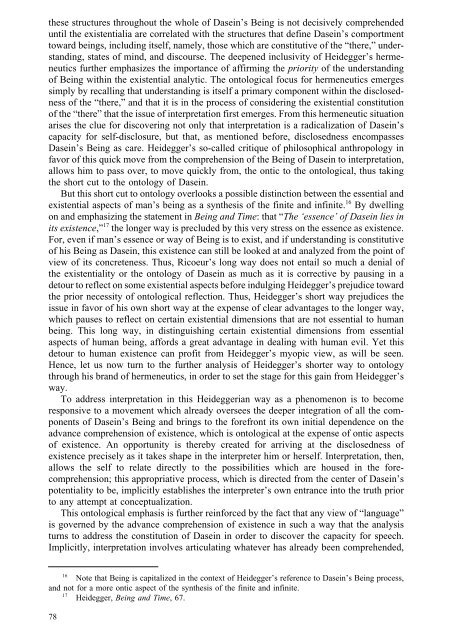[Andrzej_Wiercinski_(ed ... - WordPress.com
[Andrzej_Wiercinski_(ed ... - WordPress.com
[Andrzej_Wiercinski_(ed ... - WordPress.com
Create successful ePaper yourself
Turn your PDF publications into a flip-book with our unique Google optimized e-Paper software.
these structures throughout the whole of Dasein’s Being is not decisively <strong>com</strong>prehend<strong>ed</strong>until the existentialia are correlat<strong>ed</strong> with the structures that define Dasein’s <strong>com</strong>portmenttoward beings, including itself, namely, those which are constitutive of the “there,” understanding,states of mind, and discourse. The deepen<strong>ed</strong> inclusivity of Heidegger’s hermeneuticsfurther emphasizes the importance of affirming the priority of the understandingof Being within the existential analytic. The ontological focus for hermeneutics emergessimply by recalling that understanding is itself a primary <strong>com</strong>ponent within the disclos<strong>ed</strong>nessof the “there,” and that it is in the process of considering the existential constitutionof the “there” that the issue of interpretation first emerges. From this hermeneutic situationarises the clue for discovering not only that interpretation is a radicalization of Dasein’scapacity for self-disclosure, but that, as mention<strong>ed</strong> before, disclos<strong>ed</strong>ness en<strong>com</strong>passesDasein’s Being as care. Heidegger’s so-call<strong>ed</strong> critique of philosophical anthropology infavor of this quick move from the <strong>com</strong>prehension of the Being of Dasein to interpretation,allows him to pass over, to move quickly from, the ontic to the ontological, thus takingthe short cut to the ontology of Dasein.But this short cut to ontology overlooks a possible distinction between the essential andexistential aspects of man’s being as a synthesis of the finite and infinite. 16 By dwellingon and emphasizing the statement in Being and Time: that “The ‘essence’ of Dasein lies inits existence,” 17 the longer way is preclud<strong>ed</strong> by this very stress on the essence as existence.For, even if man’s essence or way of Being is to exist, and if understanding is constitutiveof his Being as Dasein, this existence can still be look<strong>ed</strong> at and analyz<strong>ed</strong> from the point ofview of its concreteness. Thus, Ricoeur’s long way does not entail so much a denial ofthe existentiality or the ontology of Dasein as much as it is corrective by pausing in adetour to reflect on some existential aspects before indulging Heidegger’s prejudice towardthe prior necessity of ontological reflection. Thus, Heidegger’s short way prejudices theissue in favor of his own short way at the expense of clear advantages to the longer way,which pauses to reflect on certain existential dimensions that are not essential to humanbeing. This long way, in distinguishing certain existential dimensions from essentialaspects of human being, affords a great advantage in dealing with human evil. Yet thisdetour to human existence can profit from Heidegger’s myopic view, as will be seen.Hence, let us now turn to the further analysis of Heidegger’s shorter way to ontologythrough his brand of hermeneutics, in order to set the stage for this gain from Heidegger’sway.To address interpretation in this Heideggerian way as a phenomenon is to be<strong>com</strong>eresponsive to a movement which already oversees the deeper integration of all the <strong>com</strong>ponentsof Dasein’s Being and brings to the forefront its own initial dependence on theadvance <strong>com</strong>prehension of existence, which is ontological at the expense of ontic aspectsof existence. An opportunity is thereby creat<strong>ed</strong> for arriving at the disclos<strong>ed</strong>ness ofexistence precisely as it takes shape in the interpreter him or herself. Interpretation, then,allows the self to relate directly to the possibilities which are hous<strong>ed</strong> in the fore<strong>com</strong>prehension;this appropriative process, which is direct<strong>ed</strong> from the center of Dasein’spotentiality to be, implicitly establishes the interpreter’s own entrance into the truth priorto any attempt at conceptualization.This ontological emphasis is further reinforc<strong>ed</strong> by the fact that any view of “language”is govern<strong>ed</strong> by the advance <strong>com</strong>prehension of existence in such a way that the analysisturns to address the constitution of Dasein in order to discover the capacity for speech.Implicitly, interpretation involves articulating whatever has already been <strong>com</strong>prehend<strong>ed</strong>,16Note that Being is capitaliz<strong>ed</strong> in the context of Heidegger’s reference to Dasein’s Being process,and not for a more ontic aspect of the synthesis of the finite and infinite.17Heidegger, Being and Time, 67.78


